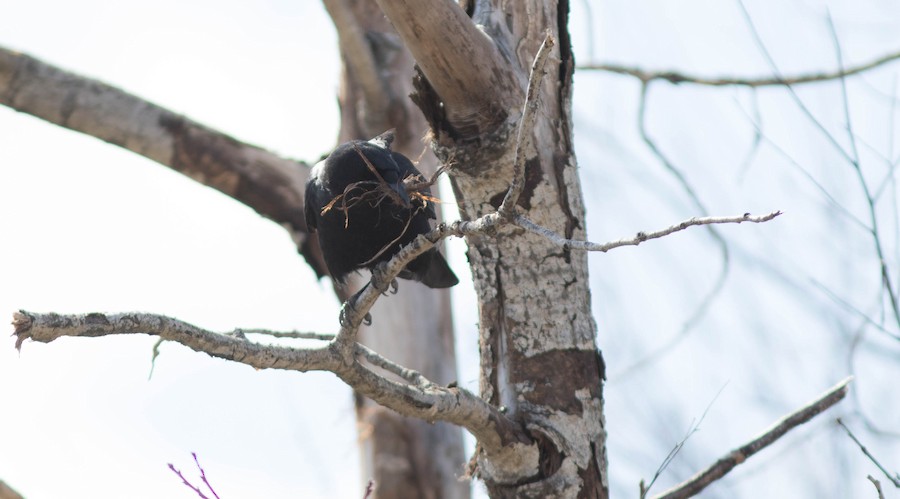ArrayMay 8, 2018 at 12:05 pm
By Doug Hithcox
As we head through April the window opens for a new group of early nesting species in Maine. This post highlights most of the species that have safe dates beginning in April. Dont forget to keep looking for breeding activity from species that started breeding in March, including: Great Horned Owls, Bald Eagles, Rock Pigeons, House Sparrows, and Peregrine Falcons. You can read ourAtlasing in Marcharticle for more details on those and other species we discussed that month.
[caption id="attachment_746" align="aligncenter" width="900"] American Crow Corvus brachyrhynchos
American Crow Corvus brachyrhynchos
Doug Hitchcox[/caption]
 American Crow Corvus brachyrhynchos
American Crow Corvus brachyrhynchosDoug Hitchcox[/caption]
What to Atlas in April:
Corvids
Common Ravens and American Crows are having a good start to their breeding cycle in Maine. You can see the breeding maps for American Crowhere; note that theyve already been confirmed as far north as two blocks in Aroostook County. Crows and ravens make large stick nests (lined with finer material) so it can be fairly easy to spot them carrying branches in flight, which you code CN-Carrying Nesting Material on your checklist. Fish Crows tend to be migratory in Maine and so have a later safe date, however they have already been confirmed breeding in Bangor the northern most breeding record for this historically southern species!Owls
Following their larger cousins, Northern Saw-whet Owls have started nesting. Now that we are within the safe dates any singing birds can be entered using the code S-Singing Bird and you can bump that record up from possible to probable if you hear that bird again seven or more days later, coded S7-Singing Bird Present 7+ Days. As of April 20th, we are in the safe dates for all owls in Maine.Resident Common Backyard Birds
An advantage to a non-migratory life is the ability to breed early. We are now within the safe dates of many of our common backyard residents including: Mourning Doves, Black-capped Chickadees, Tufted Titmice, House Finches, Northern Cardinals and White-breasted Nuthatches. Be cautious that some of these species like chickadees, titmice, and nuthatches, may use cavities for roosting (not nesting, so no code should be entered) or can make dummy nests (similar to wrens and woodpeckers) in which case you can use the probable code B-Woodpecker/Wren Nest Building.Shorebirds
Of our eight breeding species of shorebirds, two have safe dates beginning in April: American Woodcocks and Killdeer. All peenting woodcocks can now be entered as S-Singing Bird and if you observe (or more likely hear) the birds aerial display, you can bump that record up to probable nesting using C-Courtship, Display, or Copulation. Killdeer should be looked for in local areas with bare dirt or gravel, especially edges of parking lots, although it may be a few weeks before any nests show up (especially given the cold and wet spring we are experiencing). Piping Plovers are still migrating through Maine so their safe date doesnt begin until May 25th but remember that probable or confirmed codes supersede safe dates. Plovers have already been seen atGoose Rocks Beach in Biddeford, and Ferry Beach in Scarboroughwith males soldiering and scraping which is considered part of their courtship (coded C-Courtship, Display, or Copulation).Galliformes (Game Birds, etc)
Now that we are in the safe dates for these birds most are possibly in appropriate breeding locations but observers should remain careful with possible codes. Keep in mind that not all codes can be used with every species. An example within this group: thedrumming soundof territorial Ruffed Grouse is sometimes considered a song (because it is used for defending territory or attracting a mate) but for the atlas we are following theBirds of North Americaspecies account which considers this a display (coded C-Courtship, Display, or Copulation). You can always check theAcceptable Breeding Codes sheetto make sure you are using an appropriate code with the species you are reporting.Misc
There are a few other species we are within the safe dates for: Northern Goshawks, Horned Larks, Canada Geese, and both Red and White-winged Crossbills. Again, be cautious with migrating birds, especially Canada Geese or Horned Larks that may still be on their way north despite being observed in appropriate habitat.Categories
- 589